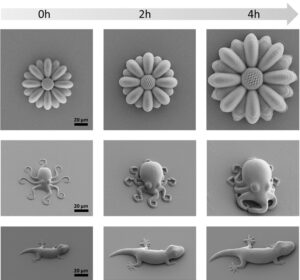
Making lifelike, 3D-printed microscopic creatures from smart polymers
Canadian Plastics
3D Printing Materials Research & DevelopmentDeveloped by scientists at Heidelberg University, the technique combines two-photon laser printing with dynamic covalent chemistry.

Due to dynamic chemical bonds, the micrometric 3D structures can grow eight-fold in just a few hours and harden. Photo Credit: C. Spiegel, Heidelberg University
In the age of smart cars and smart factories, smart polymers are only natural. These high-performance soft materials change according to the environment they’re in, making them potentially very useful for a variety of applications including some related to biotechnology and biomedicine.
In a good recent example, a team of scientists at Heidelberg University has developed a new strategy for creating “living” 3D microstructures from smart polymers that can grow in size and harden at will, potentially opening up new opportunities in fields such as micro-robotics or biomedicine by using 3D printing.
The technique combines two-photon laser printing – which allows 3D printing to be performed at the micron and nanometer scale – with dynamic covalent chemistry, which is a synthetic strategy used by chemists to make complex supramolecular assemblies from discrete molecular building blocks and which allows for reversible bond breakage and formation autonomously or in the presence of a stimulus. In particular, the Heidelberg researchers designed an ink formulation such that a kind of dynamic covalent bond known as alkoxyamine units would be incorporated into the final printed structure – these alkoxyamine bonds could then be modified after printing to add more monomers, for example, or to change the cross-linking density. “Conventional inks don’t offer such features,” said team member and Heidelberg professor Eva Blasco. “Adaptive materials containing dynamic bonds have a bright future in the field of 3D printing.”
Blasco and her colleagues identified ink components that would produce the so-called covalent adaptable microstructures (CAMs), then optimized the components’ ratios to produce the desired mix of “living” features and to print successfully. Specifically, they made sure that the ink wouldn’t require overly high laser powers or lead to slow printing speeds. Next, the researchers used a commercial direct-laser-writing system with the novel ink formulation to fabricate complex CAMs such as a sunflower, an octopus, and a gecko. A femtosecond-pulsed, near-infrared laser was focused on a tiny point within the ink solution and, through two-photon polymerization, transformed it into a solid. Many pulses of light were used to build each 3D structure, and after the print was complete, the remaining material was removed.
With different chemical reactions, Blasco and her colleagues were able to successfully alter the mechanical properties of the CAMs post-print. For example, a reaction called nitroxide-mediated polymerization chain extension introduced new monomers to the CAMs, causing them to grow eight-fold in just a few hours and harden while maintaining their shape.
“Manufacturing programmable materials whose mechanical properties can be adapted on demand is highly desired for many applications,” Blasco said.
